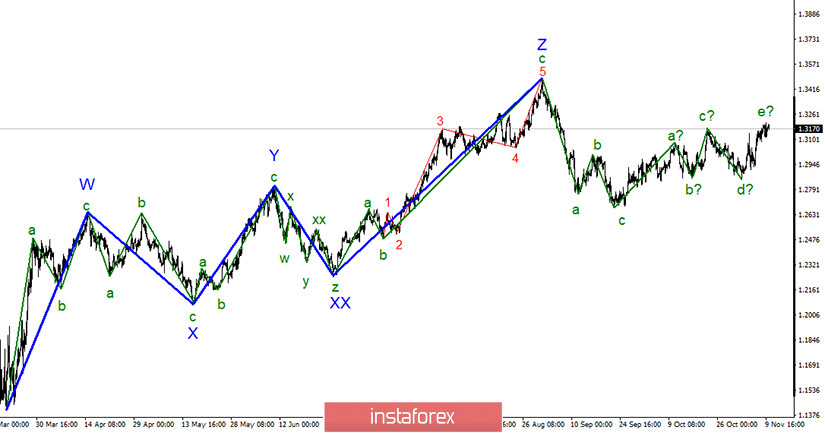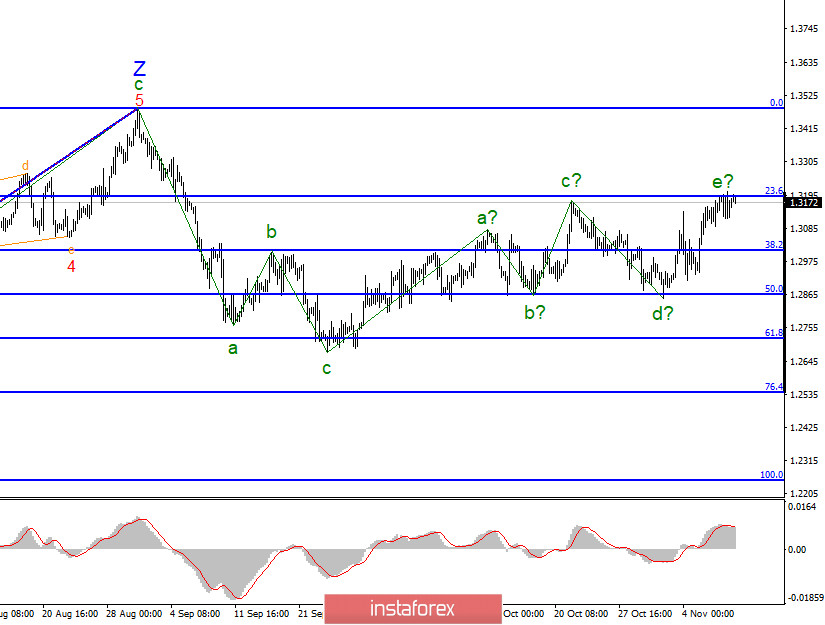
In the most global sense, the construction of an upward section of the trend can resume, but the entire wave marking takes a complex form. The section of the trend that originates on September 23 takes a five-wave form, but it is not pulsed. Thus, the construction of a new three-wave section of the trend can commence after the end of the next rising wave. However, the section of the trend from September 23 can be complicated as many times as necessary, considering that there is no classical wave marking now. The great importance for the markets currently is the news background.

On the lower chart, there were two failed attempts to break through the 50.0% Fibonacci level, which are currently interpreted as the lows of waves b and d. Thus, the wave marking really takes on a rather non-standard appearance, and the construction of the next ascending wave can be completed already at the level of 23.6% according to Fibonacci. Since an unsuccessful attempt to break the 1.3189 mark will indicate the completion of the e-wave construction, even a new downward section of the trend may start now. However, a successful attempt to break through the 23.6% Fibonacci level will further complicate the upward trend section.
Yesterday, several interesting economic reports were released in the UK. As markets expected, the unemployment rate rose to 4.8% in September, while average wages increased slightly more than expected. But in spite of the fact that the reports turned out to be opposite in nature, the British pound continued to increase in today's morning trading. The demand for the British currency is quite weak, but it is there. If the euro tends to sink more, the British pound will increase. There are no special reasons for the pound to increase now, ergo this is a bit strange. It was already mentioned earlier that there is no positive news on Brexit or negotiations on a trade deal, and there has not been in recent weeks. The Bank of England just increased its asset purchase program last week, indirectly confirming the weakness of the British economic recovery. With the coronavirus in the UK, everything remains quite tough. Despite the "lockdown" introduced by Boris Johnson until the beginning of December, so far 20-25 thousand new cases of the disease continue to be recorded every day. The total number of cases has already exceeded 1.2 million in the country of 66 million, and the number of daily cases is not decreasing. In other words, the strict quarantine is still not working yet. But, in any case, this strict quarantine will have a negative impact on the British economy, which is already experiencing far from its best times. As a result, a new decline is expected in the quotes of the instrument, unless London and Brussels, in the near future, declare that they have reached a trade agreement that will take effect from January 1, 2021.
General conclusions and recommendations:
The pound-dollar instrument has resumed building an upward trend, but its last wave may end near the 23.6% Fibonacci level. Thus, in case of a successful attempt to break the 1.3189 mark, it is advisable to buy the instrument again with targets located near the 1.3484 mark, which corresponds to 0.0% Fibonacci. Everything goes to the fact that the increase in quotes will continue at least today, ergo sales are not recommended yet.





















